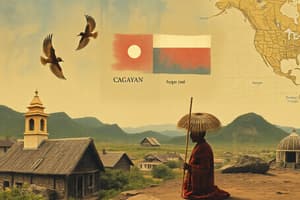Podcast
Questions and Answers
Which factor most significantly shapes the cuisine of the Cagayan Valley?
Which factor most significantly shapes the cuisine of the Cagayan Valley?
- The influence of French culinary techniques
- A reliance on processed foods due to limited agricultural capacity
- Imported ingredients from neighboring countries
- Abundance of freshwater resources and indigenous traditions (correct)
What culinary adaptation is most characteristic of Batanes cuisine?
What culinary adaptation is most characteristic of Batanes cuisine?
- Use of rare and exotic spices to enhance flavor
- Prioritization of imported ingredients over local produce.
- Focus on preservation techniques due to its island location. (correct)
- Emphasis on elaborate and decorative plating techniques.
Which of the following ingredients is most likely to be found in a traditional Ivatan dish from Batanes?
Which of the following ingredients is most likely to be found in a traditional Ivatan dish from Batanes?
- Imported European cheeses
- Tropical fruits like mangoes
- Artificial sweeteners
- Uvi (purple yam) (correct)
What distinguishes Luñis, an Ivatan dish, from typical pork adobo?
What distinguishes Luñis, an Ivatan dish, from typical pork adobo?
How does the Cagayan River influence the gastronomy of the Cagayan region?
How does the Cagayan River influence the gastronomy of the Cagayan region?
Why is meat preservation a significant feature of Cagayan cuisine?
Why is meat preservation a significant feature of Cagayan cuisine?
What distinguishes Longganisa de Tuguegarao from other Filipino longganisas?
What distinguishes Longganisa de Tuguegarao from other Filipino longganisas?
What agricultural product is Isabela primarily known for?
What agricultural product is Isabela primarily known for?
What culinary trend is emerging in Isabela, reflecting its modernization?
What culinary trend is emerging in Isabela, reflecting its modernization?
What is a defining characteristic of Quirino's cuisine?
What is a defining characteristic of Quirino's cuisine?
Flashcards
Cagayan Valley Cuisine
Cagayan Valley Cuisine
A food-rich region in northeastern Luzon, Philippines, shaped by indigenous traditions, agriculture, and preservation.
Batanes Cuisine
Batanes Cuisine
Prioritizes preservation, sustainability, and seafood due to isolation and climate.
Uvi
Uvi
Purple yam used in various dishes.
Vunes
Vunes
Signup and view all the flashcards
Dibang
Dibang
Signup and view all the flashcards
Uvud
Uvud
Signup and view all the flashcards
Cagayan Ibanag Cuisine
Cagayan Ibanag Cuisine
Signup and view all the flashcards
Pancit Batil Patung
Pancit Batil Patung
Signup and view all the flashcards
Longganisa de Tuguegarao
Longganisa de Tuguegarao
Signup and view all the flashcards
Isabela Cuisine
Isabela Cuisine
Signup and view all the flashcards
Study Notes
Cagayan Valley Overview
- Region II, is a food-rich region in northeastern Luzon.
- The Sierra Madre, Cordillera, and Caraballo mountain ranges, and the Cagayan River border it.
- The Cagayan River is the country’s longest river.
- Indigenous traditions, agricultural abundance, freshwater and marine resources, and preservation techniques shape its cuisine.
- The main ethnic groups are the Ibanag, Itawes, Gaddang, Ivatan, and Ilocano.
- Each ethnic group has distinct culinary traditions.
General Characteristics of Cagayan Valley Cuisine
- Abundance of freshwater and marine resources benefits the region.
- The Cagayan River, its tributaries, and the Pacific Ocean provide fish, crustaceans, and shellfish.
- Cagayan Valley is known as the "Rice Granary of the North."
- Vast quantities of rice, corn, and other agricultural products are produced.
- The cuisine reflects the traditions of the Ibanags, Itawis, Gaddangs, and other indigenous groups.
- Native ingredients and cooking methods are incorporated.
- Spanish influences are evident in certain dishes and cooking techniques.
- Spices and stews are used in particular.
- The emphasis is on highlighting the natural flavors of ingredients.
- Simple preparations like grilling, boiling, and stewing are often used.
Batanes Cuisine (Island Flavors and Survival Cuisine)
- Batanes is the northernmost province of the Philippines.
- The food culture is centered around preservation, sustainability, and seafood-based dishes.
- This is due to its isolation and unpredictable climate.
- Batanes is an archipelago exposed to harsh weather.
- The cuisine prioritizes preservation and resourcefulness.
Key Ingredients in Batanes Cuisine
- Uvi (Purple Yam): A staple crop used in various dishes, from simple boiled uvi to complex desserts.
- Kamote (Sweet Potato): Another vital crop, providing sustenance and versatility.
- Flying Fish (Dibang): A seasonal delicacy, often dried or preserved.
- Lobster (Payi): Abundant in the surrounding waters, grilled or boiled.
- Coconut Crab (Tatus): A prized crustacean, cooked in coconut milk or grilled.
- Vunes: Salted pork preserved inside a clay jar.
- Luñiz: Salted pork similar to vunes, but dried.
Culinary Characteristics of Batanes Cuisine
- Preservation techniques are essential.
- Emphasis is placed on root crops.
Key Culinary Features/Characteristics of Batanes Cuisine
- Drying, salting, and smoking are essential for preserving food without modern refrigeration in Batanes.
- Dibang (Flying Fish): Sun-dried or smoked, commonly fried or grilled.
- Vunes are dried gabi (taro) stalks, rehydrated and cooked in coconut milk.
- Luñis is Ivatan-style pork adobo, salted and slow-cooked in its own fat, for shelf-stability.
- Pinipa is sun-dried dolphin fish (mahi-mahi), stored long-term.
- Pusit Ivatan is dried squid, commonly grilled or added to stews.
Heirloom Dishes in Batanes
- Uvud consists of meatballs made from banana pith, ground meat, and fish.
- Payi (Sea Urchin Rice) is cooked rice mixed with sea urchin roe, for its rich, briny taste.
- Supas is Ivatan turmeric rice, often served with dried fish.
- Pinakbet Ivatan includes taro, sweet potato, eggplant, and fermented fish.
- Dibang Silog is fried flying fish served with garlic rice and eggs.
Batanes Root Crop Staples
- Uvi and kamote provide carbs and nutrients.
- Tamiduk is taro leaves cooked in coconut milk, similar to laing.
- Dukay is a sweet yam (ube) pudding with coconut milk and sugar.
- Katutdaw are boiled sweet potatoes, eaten as a staple food.
- Kamote Balls are mashed sweet potato snacks rolled into balls and fried.
- Badu is a dessert of mashed yam, sugar, and coconut milk.
- Dishes are often cooked with minimal ingredients.
- The natural flavors of the seafood and root crops are highlighted.
- Raw fish consumption and harsh weather preservation techniques exist.
Cagayan: Ibanag and Itawes Gastronomy
- Cuisine defined by riverine food sources, meat preservation, and noodle dishes.
- Influenced by Ibanag, Itawes, and Ilocano culinary traditions.
Key Ingredients in Cagayan Cuisine
- River Fish (e.g., Ludong) is abundant in the Cagayan River, grilled, stewed, or fried.
- Longganisa de Tuguegarao is a garlicky and flavorful sausage.
- Baggo Rice is a local strain of rice.
- Batac Empanada is a savory pastry with ground meat, vegetables, and longganisa.
- Pancit Batil Patung is a noodle dish with carabao meat, poached egg, and vegetables.
Key Culinary Features of Cagayan Cuisine
- Pancit Batil Patung includes stir-fried miki noodles with carabao meat, poached egg, and egg-drop soup.
- Igado is pork liver and meat stew with vinegar and soy sauce.
- Chicharabao is crispy carabao skin chicharon.
- Longganisa Tuguegarao is garlicky pork sausage, known for its deep flavor.
- Binas-usan is a dish of pork intestines stewed in vinegar and garlic.
- The Cagayan River plays a vital role as freshwater and riverine identity.
- Ludong (President’s Fish) is a rare, expensive fish found in the Cagayan River.
- Sinanta is a noodle soup with chicken, shellfish, and rice noodles.
- Adobo Ilaw is chicken intestines stewed in vinegar.
- Pinais is freshwater shrimps cooked in banana leaves.
- Dinakdakan Itawes is grilled pig’s face with vinegar, onions, and liver spread.
Cagayan Rice-Based Delicacies
- Pawa consists of sticky rice balls with sweet peanut filling.
- Inatata consists of glutinous rice in banana leaves, cooked in coconut milk.
- Binallay is a suman-like rice cake served with latik (coconut caramel).
- Patupat consists of glutinous rice pouches wrapped in palm leaves, boiled in sugarcane juice.
- Alupi is a cassava and coconut cake, steamed and served as a snack.
- Longganisa de Tuguegarao and Batac empanada showcase bold flavors.
- Pancit Batil Patung is a popular noodle dish.
- Ludong fish is considered one of the most expensive fish in the Philippines.
- Tuguegarao Longganisa has a very strong garlic flavor.
- Ilocano cuisine strongly influences western Cagayan.
Isabela: Agricultural Abundance and Culinary Innovation
- Isabela is known for its corn-based dishes, pancit varieties, and heirloom recipes.
- Ilocano and Ibanag cuisine influences it.
Key Ingredients in Isabela Cuisine
- Corn: Isabela is a major corn producer, used in dishes like corn soup and corn grits.
- Rice: The province is a significant rice producer with various rice varieties.
- Carabao Milk and Products: Used to make kesong puti and other dairy products.
- Citrus Fruits: Isabela is known for citrus fruits, used in juices and desserts.
- Callos: stew of ox tripe.
Key Culinary Features/Characteristics of Isabela Cuisine
- Binallay is a sticky rice cake with latik.
- Nilulutok is a sweet corn porridge with coconut milk.
- Binungey is sticky rice cooked inside bamboo tubes.
- Pancit Cabagan is a saucy egg noodle dish with pork and quail eggs.
- Pinaltit is a sticky corn cake wrapped in banana leaves.
Notable Isabela Meat and Vegetable Dishes
- Gawa-Gawa is vegetable stew with squash, string beans, and bagoong.
- Tupig Isabela is grilled glutinous rice cake with coconut and sugar.
- Sinalab is smoked meat, pork or beef.
- Linubian is sticky rice cake with coconut and anise.
- Dinengdeng is vegetable stew with fermented fish sauce.
- Agricultural diversity has led to a diverse culinary landscape.
- Carabao milk and kesong puti are prominent.
- Modern restaurants experiment with fusion cuisine, blending local and international flavors.
- Isabela is modernizing its food industry, experimenting with old dishes.
- Corn leads to creation of corn based dishes.
Nueva Vizcaya: Highland and Lowland Fusion
- Cuisine reflects Gaddang and Ilocano influences.
- Focus on root crops, highland vegetables, and freshwater dishes.
Key Ingredients in Nueva Vizcaya Cuisine
- Wild Game (Deer, Wild Boar): Hunting provides wild game for special occasions.
- Root Crops (Gabi, Ube): Abundant in the highlands, used in stews and desserts.
- Citrus Fruits: The province produces citrus.
- Native vegetables: such as ferns.
Key Culinary Features/Characteristics of Nueva Vizcaya Cuisine
- Cuisine reflects the terrain and indigenous traditions.
- Pinikpikan is smoked chicken stew, a Cordilleran specialty.
- Lagat Paria is bitter gourd stew with fish flakes.
- Tupig Vizcaya is grilled rice cake with coconut.
- Insarabasab is grilled pork salad with vinegar and onions.
- Dinardaraan is blood stew similar to dinuguan, but chunkier.
- Wild game is significant, particularly among indigenous communities.
- Root crops are used in traditional dishes.
- Indigenous people understand the local flora/fauna.
- Wild game is heavily regulated.
Quirino: The Land of Forest Flavors
- Cuisine is forest-based, focused on foraged ingredients, freshwater fish, and carabao dishes.
Key Ingredients in Quirino Cuisine
- Forest Products (Wild Honey, Mushrooms): Forests provide edible products.
- River Fish: Rivers and streams are home to fish species.
- Root Crops: Grown in agricultural lands.
- Citrus: Produced similarly to Nueva Vizcaya.
Key Culinary Features/Characteristics of Quirino Cuisine
- Foraged & Indigenous Ingredients highlight province's resources.
- Kulibangbang Leaves – Used in soups and stews.
- Pako Salad – Salad made from wild ferns.
- Pinaltit – River snails in coconut milk.
- Grilled Native Tilapia – From local rivers.
- Carabao Kinilaw – Raw carabao meat cured in vinegar.
- Quirino is developing tourism through new restaurants and culinary experiences.
- Cuisine is simple and rustic, showcasing natural ingredient flavors.
- Local government is promoting sustainable tourism, showcasing culinary heritage.
- Wild honey is considered high quality.
Conclusion: Cagayan Valley Cuisine
- Cuisine reflects indigenous heritage, resourcefulness, and agricultural richness.
- One of the most diverse culinary regions in the Philippines.
Studying That Suits You
Use AI to generate personalized quizzes and flashcards to suit your learning preferences.




